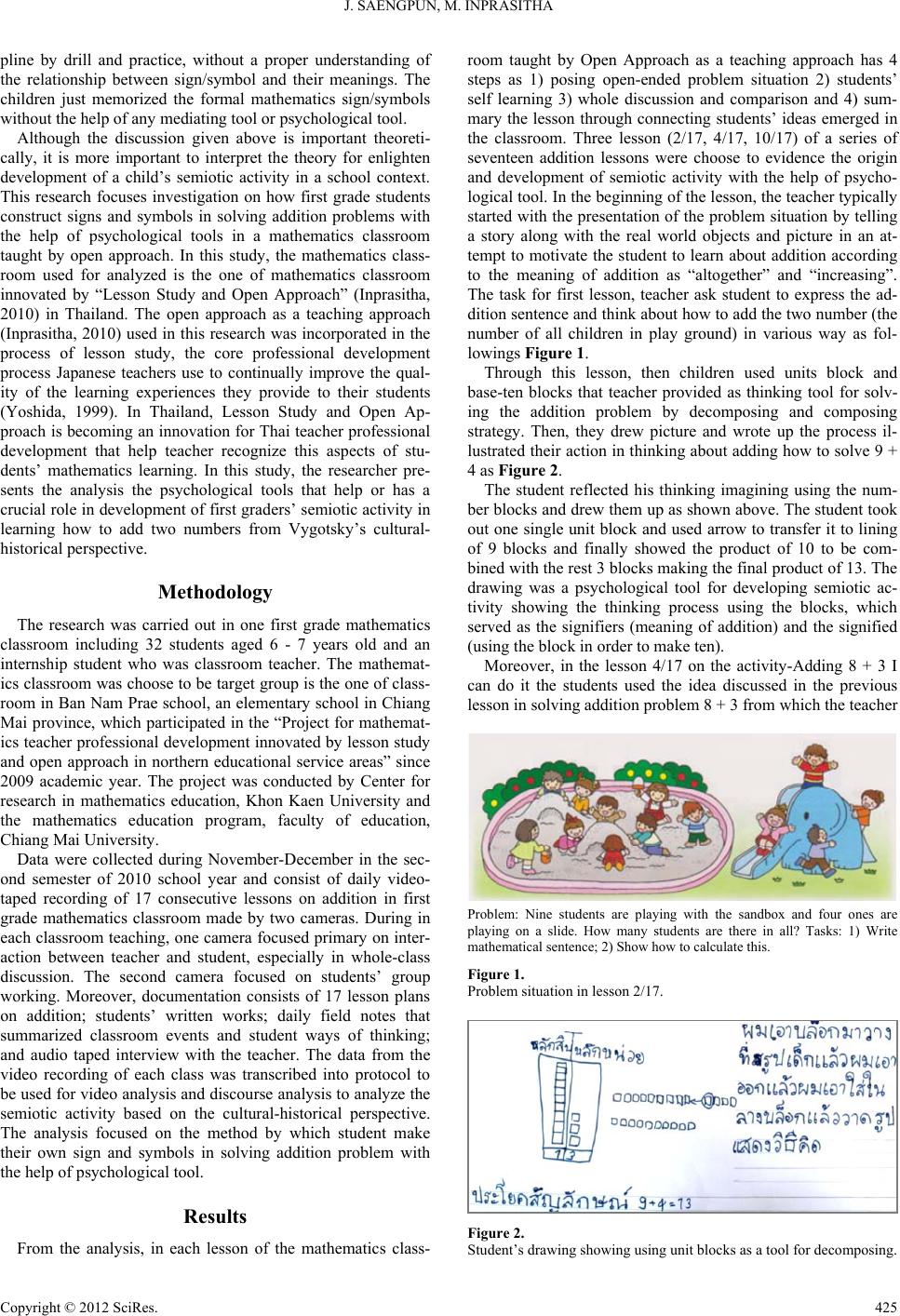
J. SAENGPUN, M. INPRASITHA
pline by drill and practice, without a proper understanding of
the relationship between sign/symbol and their meanings. The
children just memorized the formal mathematics sign/symbols
without the help of any mediating tool or psychological tool.
Although the discussion given above is important theoreti-
cally, it is more important to interpret the theory for enlighten
development of a child’s semiotic activity in a school context.
This research focuses investigation on how first grade students
construct signs and symbols in solving addition problems with
the help of psychological tools in a mathematics classroom
taught by open approach. In this study, the mathematics class-
room used for analyzed is the one of mathematics classroom
innovated by “Lesson Study and Open Approach” (Inprasitha,
2010) in Thailand. The open approach as a teaching approach
(Inprasitha, 2010) used in this research was incorporated in the
process of lesson study, the core professional development
process Japanese teachers use to continually improve the qual-
ity of the learning experiences they provide to their students
(Yoshida, 1999). In Thailand, Lesson Study and Open Ap-
proach is becoming an innovation for Thai teacher professional
development that help teacher recognize this aspects of stu-
dents’ mathematics learning. In this study, the researcher pre-
sents the analysis the psychological tools that help or has a
crucial role in development of first graders’ semiotic activity in
learning how to add two numbers from Vygotsky’s cultural-
historical perspective.
Methodology
The research was carried out in one first grade mathematics
classroom including 32 students aged 6 - 7 years old and an
internship student who was classroom teacher. The mathemat-
ics classroom was choose to be target group is the one of class-
room in Ban Nam Prae school, an elementary school in Chiang
Mai province, which participated in the “Project for mathemat-
ics teacher professional development innovated by lesson study
and open approach in northern educational service areas” since
2009 academic year. The project was conducted by Center for
research in mathematics education, Khon Kaen University and
the mathematics education program, faculty of education,
Chiang Mai University.
Data were collected during November-December in the sec-
ond semester of 2010 school year and consist of daily video-
taped recording of 17 consecutive lessons on addition in first
grade mathematics classroom made by two cameras. During in
each classroom teaching, one camera focused primary on inter-
action between teacher and student, especially in whole-class
discussion. The second camera focused on students’ group
working. Moreover, documentation consists of 17 lesson plans
on addition; students’ written works; daily field notes that
summarized classroom events and student ways of thinking;
and audio taped interview with the teacher. The data from the
video recording of each class was transcribed into protocol to
be used for video analysis and discourse analysis to analyze the
semiotic activity based on the cultural-historical perspective.
The analysis focused on the method by which student make
their own sign and symbols in solving addition problem with
the help of psychological tool.
Results
From the analysis, in each lesson of the mathematics class-
room taught by Open Approach as a teaching approach has 4
steps as 1) posing open-ended problem situation 2) students’
self learning 3) whole discussion and comparison and 4) sum-
mary the lesson through connecting students’ ideas emerged in
the classroom. Three lesson (2/17, 4/17, 10/17) of a series of
seventeen addition lessons were choose to evidence the origin
and development of semiotic activity with the help of psycho-
logical tool. In the beginning of the lesson, the teacher typically
started with the presentation of the problem situation by telling
a story along with the real world objects and picture in an at-
tempt to motivate the student to learn about addition according
to the meaning of addition as “altogether” and “increasing”.
The task for first lesson, teacher ask student to express the ad-
dition sentence and think about how to add the two number (the
number of all children in play ground) in various way as fol-
lowings Figure 1.
Through this lesson, then children used units block and
base-ten blocks that teacher provided as thinking tool for solv-
ing the addition problem by decomposing and composing
strategy. Then, they drew picture and wrote up the process il-
lustrated their action in thinking about adding how to solve 9 +
4 as Figure 2.
The student reflected his thinking imagining using the num-
ber blocks and drew them up as shown above. The student took
out one single unit block and used arrow to transfer it to lining
of 9 blocks and finally showed the product of 10 to be com-
bined with the rest 3 blocks making the final product of 13. The
drawing was a psychological tool for developing semiotic ac-
tivity showing the thinking process using the blocks, which
served as the signifiers (meaning of addition) and the signified
(using the block in order to make ten).
Moreover, in the lesson 4/17 on the activity-Adding 8 + 3 I
can do it the students used the idea discussed in the previous
lesson in solving addition problem 8 + 3 from which the teacher
Problem: Nine students are playing with the sandbox and four ones are
playing on a slide. How many students are there in all? Tasks: 1) Write
mathematic al sentence; 2) Show how to calculate t his.
Figure 1.
Problem situation in lesson 2/17.
Figure 2.
Student’s drawing showing using unit blocks as a tool for decomposing.
Copyright © 2012 SciRes. 425